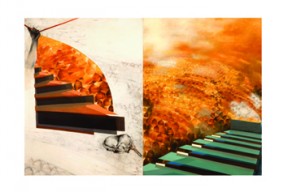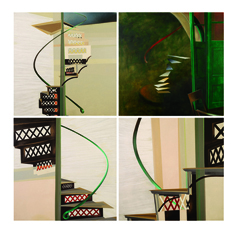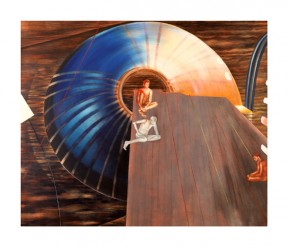Life-size canvases with strong figurative forms – whose inherent masculinity filled up the pictorial space with an overpowering sense of physicality – is what artist Shruti Gupta Chandra has been famous for. In her latest solo show titled Counter Gaze, however, she springs a surprise with a marked turn in her oeuvre. The scale of her work remains the same – some works as large as 6 feet by 5 feet – and so does the ideology of articulating her concern about human life within fast growing urban spaces but now this artistic sensibility is shown in more subtle tones. She has moved away from a figurative language to explore a far more abstract artscape full of grids and staircases.
Says Shruti Gupta Chandra: “While it is obvious that urbanisation is meant for the welfare of human beings, we also can’t doubt that it often contributes to their suffering. It is this irony of human existence that I have tired to capture in my work.”
The artist is concerned with the dichotomy that an individual living in a teeming metropolis faces. Swamped with loneliness and a rapid breakdown of relationships, he searches for sustenance. Added to this is the strange amalgam of the old and new- the erosion of all that one held sacred – values, principles, ideals – by the invasion of a brittle brightness. But despite all this, he is not just a victim. He has an inner intrinsic strength that enables him to cope and sustain, and also hope.
Hence, urban spaces, their importance as an aspirational desire, the human angst they create and the fact that they are slowly but aggressively taking over rural spaces is what forms the core of Shruti’s work. In a large-sized acrylic on canvas (40×70 inches) titled, I Hope To Find, she acknowledges, through symbolism of staircases, that this intrusion is also changing the rural landscape, affecting their climatic balance and even rewriting their history.
In another work, made up of four panels of 40 inches each, titled Castles in the Air, the flight of stairs seems to take the climber into an ideal space where everyone is given equal rights and justice. This imagery of stairs, in fact, sets the tone of her latest series of works. In one of her diptychs, titled I Tried to Climb Yesterday, Shruti directly deals with the history of a new urban space set against the backdrop of an older space. Shruti does not tell the viewers where the stairs are leading them to. Instead, she creates symbols – like a sleeping dog or a hand that tugs at a string – to portray the tension and lethargy human beings experience in such spaces.
What is also visually arresting in this new body of work is how the artist has used ‘grids’ to deconstruct existing realities. Unlike in her earlier works, she builds a pattern of grids so that a viewer can negotiate reality in both an aesthetic and philosophical way. In works such as Towards And Away and The Folds Opened Out, these grids, almost having the serenity of a gauche on paper or linen, could be interpreted as the abstract representations of urban-scapes.
One can find Shruti’s involvement with the beauty of the human body in most of these works too, although considerably moderated and muted. These solidly drawn male human figures seem distorted to some extent to emphasize the feeling of dislocation in human beings. And wherever Shruti has used human figures, they are depicted as thoughtful beings (Alter Ego, As The World Spun) which represents the dizziness of those caught in the dynamics of urbanisation.
In another painting titled Yesterday Unravels, Today Engulfs, she creates this movement in the form of a trapeze net or huge mosquito net tied within a historical architecture that represents the old and sustainable urbanization projects. In this net, human beings are seen as if they were washed away by a gushing stream; a metaphor for the dynamics of history.
In I See, I Wait, I Believe, she uses the human figure as an isolated being within a complex landscape of grids. For the artist, and indeed most of us, the fact is that one is alone in a very special way in urban life.
The show is being presented as the launch show of Gallery Artspeaks India and will be held at Galerie Romain Roland, Alliance Francaise from September 29 till October 6, 2011 after which it will continue at Gallery Artspeaks India, Said-ul-ajaib, New Delhi from October 11 till October 31, 2011.
Poonam Goel is a freelance journalist and has covered the arts for over 15 years. She contributes on visual arts for various newspapers, magazines and online media. More about her on Story Wallahs. Write to her @ poonamgoel2410@gmail.com








